
Nina Freeman is a game designer and streamer based in Portland, OR. She’s best known for games like Cibele and “how do you Do It?”. This year, she released a collection of romantic comedy vignette games called We Met in May, created alongside her partner Jake Jefferies, with music by Ryan Yoshikami. You can follow her on Twitter at @hentaiphd or check out her streams every week on Twitch.
You’re probably here to read about my favorite games from this year, but first I’m going to keep it kinda personal. Games are a very personal thing for me--they’re my work and my fun. Whenever I reflect on my experiences with games in the past year, I’m also reflecting on my experiences just… in life.
I worked hard this year to figure out where I want to be next--I’m not just barreling ahead blindly anymore, like I did in my early 20s when I started making games in 2012/13. I was just a kid in New York City partying and working (too much). I just wanted to have fun and make stuff! All the time! Then, soon enough, games were my career. I worked hard on games all day, and then worked more on other games at night. This experience shaped almost my entire last decade. I’m turning 30 next year, and I know it’s just a number but… I feel like my relationship to games and game making has come to a turning point right as I leave my 20s behind, so I’ve been trying to make sure I’m headed in the right direction.
This year, finally, I was deliberate. I shipped a game without working every night or burning myself out, I grew my stream, I maintained my friendships and found some new ones. I even made some big career decisions! I’m going to be working full-time on my own games in 2020. This is something I never dreamed I’d be able to do, especially not when I started making games for fun back in 2012/13.
I’m really proud of the career I’ve built over the last 10 years. I didn’t make a hit and get rich or land some fancy AAA job. It wasn’t easy and it took a long time, but I managed to build enough of a base to try doing my own thing for a little bit. I thought I should share this, in case anyone reading is in the middle of that process. Sometimes life and career stuff can seem bleak, or like it’s taking forever to get going… it can take a long time, but if I can do it, you can too. <3 Now, I can clearly see the kinds of games I care about, and the work in games that I want to pursue. Supporting the community I’ve built through streaming, running game jams, leading my own game projects… these are the things that make me happy and the things I’ll pursue full force as we enter the 2020s.
Devotion
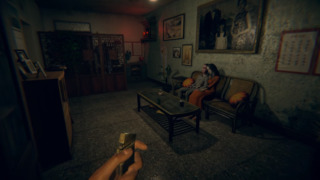
Devotion is stunning. It’s about loss, fear of the unknown, and the things humans do to feel like they have any control over their lives. It’s the most important video game made in recent memory. I suppose no one should be surprised it’s at the top of my list, given how much I loved the studios last game, Detention (which was at the top of my GoTY list in 2017, haha). I think Red Candle Games is doing my favorite work in the industry, and I feel strongly that their games will prove to be timeless.
Set in Taiwan during the 1980s, Devotion depicts a husband, wife and young daughter. The game is about a family tragedy, revolving around the daughter, Mei Shin, who they believe is ill. The family lives in a modest apartment in Taipei, which you spend most of the game exploring. The apartment itself is one of the main characters, as its identity shifts over the course of the game, relaying the story that happened there. For example, the game starts during a seemingly normal year, and the apartment has the sort of clutter you might expect from a family. Then, soon enough, after an excursion into the hallways, you’re back in the apartment but… it’s almost empty. With some investigation, it becomes clear that you’re in the apartment when the family was first moving in, before they’re fully unpacked. The game employs this P.T.-like approach throughout the game, but fleshes out that core loop. The apartment changes when you enter it again, but sometimes it changes even between the moments of entering and exiting a room.
There is no place this apartment is afraid of taking you. You even end up inside the dilapidated fish tank at one point--the daughter is sick of taking her medication, and dumped it all into the fish tank. You take on the perspective of the unfortunate fish, looking up helplessly as the massive pills float down all around you. At another point, you’ve left the living room to explore Mei Shin’s room during a time of… relative happiness. You turn to leave, and the living room is now completely changed--Mei Shin’s birthday cake sits in front of the couch, surrounded by red candles, and photos of Mei Shin line the walls. The apartment is alive in a way, and it’s as colorful and complicated as its inhabitants, and it wants to tell you their story.
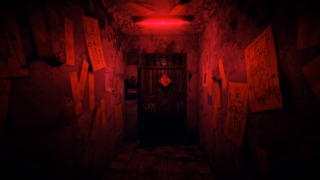
Devotion is a beautiful and eerie game that tells a human story. It reminds me of something like Jeffrey Eugenides' The Virgin Suicides, a classic novel that revolves around mundane horrors unfolding in a suburban household. Stories expressed through the home are not unheard of in games or other media, but Devotion takes the form to another level. Also, horror has been having a renaissance in general, I think. It’s no surprise to me that Red Candle Games has contributed yet another masterpiece to the genre, and to video games at large.
P.S. I know that Devotion is banned and that you can’t play it if you didn’t buy it in that first week or two of it being out. I didn’t want to write about that because people who are more educated than me about that issue have already written about it all over the internet. I wanted to focus on the game itself, because it’s a masterpiece despite anything that has happened to/around it. If you don’t have the game, find someone who does and play it. Or, watch a playthrough! I have personally streamed it twice (with Mary Kish and then with my friend Wes), and will try to stream it again in the future, for the benefit of folks who don’t have it. I highly encourage folks support Red Candle Games by buying and playing their previous game (another gosh darned masterpiece), Detention.
Eliza
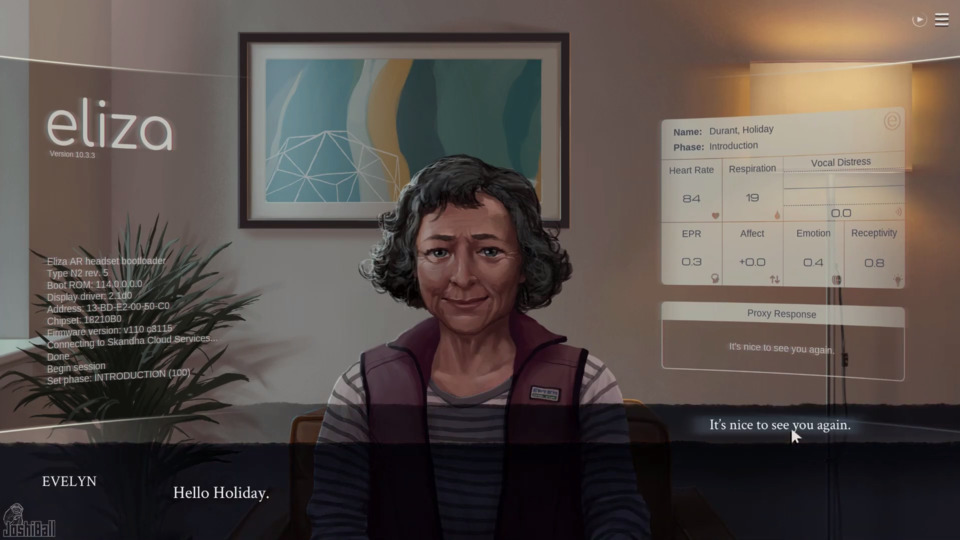
Eliza is a brilliant sci-fi game that feels like it could be happening right now, in real life. It’s about a start-up company making an A.I. therapist for the masses. It’s a visual novel in form, and you play as a young woman named Evelyn who works at this company in Seattle. During the game, you conduct therapy sessions where you act as the human face for the A.I., repeating what it tells you to say to the person seeking help. It’s really interesting, because typically in a visual novel, you expect every choice to lead to different branches of dialogue, or that each choice might affect some kind of ending. In Eliza, the visual novel dialogue choice format is embedded firmly in the reality of Evelyn’s job. She doesn’t have a choice in the matter (at least at the beginning…), she is there to work, and her work is to say exactly what the A.I. tells her to say. You have a dialogue choice, but it’s not really a choice. You’re just a talking head for the A.I. It’s a really compelling moment, the first time you conduct a therapy session in Eliza. You instantly wonder… well, what if I don’t say what the A.I. tells me to? This question is not answered right away, but it lingers.
The game progresses and Evelyn has some agency in various situations, so you do eventually get some more traditional dialogue choice moments. You have conversations outside of work, and you learn more about her various relationships and her personal struggles with work. She has a personal history with the technology, which you learn about. The game looks at a number of complex issues head-on--what happens when we leave our mental health in the hands of a computer? Who are the people behind the technology that thousands of people are dependent on for essential care? What assumptions are embedded in that technology, and how does that affect a real person, with real problems?
It also acknowledges and considers the outcome of this kind of work on the individual. Burn out and start-up culture are critiqued in various ways throughout the game by digging into Evelyn’s specific, personal story. It’s a brilliantly written game that feels very important in our current world. We are already dependent on technology to the extent depicted in Eliza. We already have the start-up culture that is depicted in Eliza. There may not be a wildly mainstream A.I. therapist out there yet… but it’s likely not far off, especially with the high cost for mental health services, in the U.S. at least. Eliza is not shy about being critical of the role of technology in our culture, lives and world. It offers a really important space for us players to consider those things, which do and will affect us far into the future.
Anodyne 2: Return to Dust
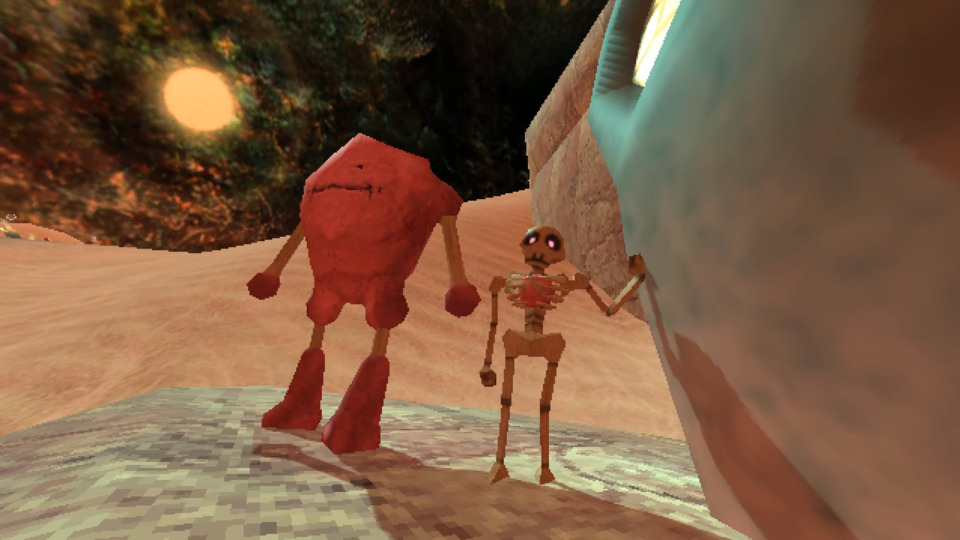
Anodyne 2 is a game about a kid finding her place in the world and the truth in her heart. You play as young Nova, a Nano Cleaner, set to the task of purging her world of Dust. Dust is corrupting people, according to Nova’s two moms and their authority, the Center. The world is full of folks who are in danger or pain. You need to help them, so there’s a lot of work to do! Gustine Papellum, for example, who looks like a big tongue… the Dust made them gluttonous, losing themselves in the pleasures of taste. Or Geof, the prideful mayor of a once fertile farming town, who refuses to relocate the town despite having its ecosystem ruined by Dust. Nova is there to help in various ways. Though she can’t always fix their problems, she at least helps them find closure.
Each time she encounters one of these troublesome situations, she shrinks into Nanoscale, entering the character’s inner world. The game literally transitions from 3D environments to 2D dungeons that contain Zelda-like puzzles and a little combat. Each dungeon is designed to communicate the situation the character is in who Nova is trying to help. For example, in the prideful Mayor Geof’s level, you get to explore a 2D version of the town when it was in good health. Some are literal like that, other levels are more metaphorical. Anodyne 2 does not cut any corners when it comes to worldbuilding. Each dungeon is unique--the art, the kinds of puzzles you encounter, the friends and enemies inside. It builds and fleshes out the world of New Theland to an extent that I would never expect possible from such a small team of developers. Sean and Marina (the devs) are absolute geniuses of creating worlds and characters that feel alive.
You can tell they care deeply about the world and its inhabitants as well. You’re not just there to see these things--you’re asked to empathize with and deeply understand the world and its issues through the mechanics and storytelling. Even characters you only encounter briefly are treated with care. Fukuchi, for example--a character who has gone away to travel, and is missed by her fellow townsfolk. You encounter her later in one of the 2D dungeons, where she explains that she left to experience the world outside of her home. She had hopes and dreams to see things--a sort of “the grass is greener on the other side” mentality. However, once you find her… I won’t spoil it too much, but she’s realized that the world outside of her small town did not live up to her hopes and dreams. It’s a small and sad story, but one that resonated with me a lot. I had this feeling repeatedly throughout Anodyne 2. All of the little stories you encounter throughout the game leave such a real impact, and ask you to reflect on things that are very human--love, friendship, authority, family, loss… Anodyne 2 is a beautiful game full of amazing stories that make up a vivid and unique world.
Elsinore
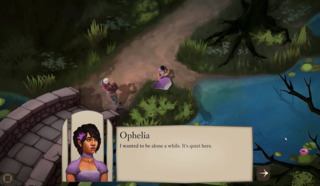
Elsinore is a game based on Shakespeare’s Hamlet. You play as Ophelia, and your goal is to prevent bloody mayhem. Literally, you spend your time exploring the world of Hamlet trying to gather and share the information required to socially manipulate people into not killing each other. It’s a smart and fun re-interpretation of Hamlet that could only be done by a game. Preventing the murders is all about choosing what information to share with who and when. You can’t just stand back and let things happen naturally, or people will die. You have to get out there and eavesdrop and gossip to find key nuggets of information. Then share your findings with the right people at the right time. Fail to warn Polonius of Hamlet’s murderous intent at the right time, and he’ll die. Fail to untangle the mystery of your own murder in time, and you’ll die. The act of choosing what to share and when with each character at any given moment is something that games as a medium enables, and Elsinore capitalizes on that beautifully. It’s such a dense and thought-provoking design that embodies the social systems that Shakespeare wrote about so well.
The English major in me felt super pleased playing it, because I’m personally familiar with the act of untangling Shakespeare texts, and I can really see that the developers know their stuff. Playing the game brought me back to when I’d spend hours studying Much Ado about Nothing back in high school. I played Beatrice in a play, and got into her head through the many rehearsals and hours spent with her lines. I’m very familiar with the task of getting into the heads of Shakespeare's characters, and trying to make sense of all the social structures and politics that drive them to do what they do. Understanding that stuff is key to getting into character, and performing well. Elsinore brings you through the loop of Hamlet many times, just like I went to rehearsal many times. The time-looping mechanic, like my rehearsals, gives you the time and space to develop the complex understanding required to make the right decisions, and to navigate the social network of Hamlet. The way information builds from loop to loop is super satisfying, and I had the kind of fun playing it that I haven’t felt since my rehearsals during high school theatre.
Dota 2
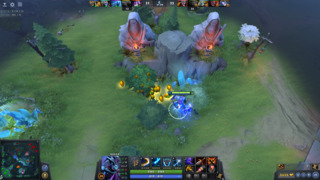
I can’t believe I’m sitting here writing about Dota 2 for my game of the year list in 2019… lol. It probably doesn’t need an introduction, given its long-time high profile status. Regardless, if you have no idea what it is, it’s basically an online multiplayer game where you are trying to protect your team's base while attempting to destroy the opponents. In retrospect, I suppose it’s no surprise that I like Dota 2. It’s kind of like… the ultimate game design nerd game. It has the kind of mechanical depth that takes a ton of time and practice to master (if it’s even possible to master, which is arguable). The mechanics are also fun in their tone--it doesn’t take itself entirely seriously. You can play a character that cracks a lightning whip, or a character that hurls entire trees at enemies, or one that soaks an enemy in beer. I really appreciate how a game with elegant systems that mesh as well as Dota’s is also not afraid of being a little silly in the narrative context of those systems.
It’s also a game with a history as deep as its systems. Dota has gone through many, many design iterations over the years. It’s almost like… a folk game. Even though it’s a Valve-owned thing now, it started out as a community driven creation as a Warcraft III mod. It’s really rare to play a game in the digital space that has been iterated on as much as Dota 2 has been, especially one that was originally devised outside the confines of a company. It’s pretty inspiring to see that any game could have this kind of lifetime in the digital space. I have had a ton of fun learning and playing Dota 2 this year… it’s definitely become my go-to game when I want to have fun practicing and improving at something. It feels so satisfying to learn and play.
Life is Strange 2

I wrote about the first episodes of Life is Strange 2 last year. I said I was excited to see where the game would go next, and I have to say, I was NOT disappointed. All of the episodes are now out, and I’m happy to say that Life is Strange 2 is probably one of my favorite games of the last decade.
One of the most important things I took away from the game is that a masterful melding of the political with the personal leads to storytelling that feels so real it hurts. Within two episodes, I experienced the most human sex scene I’ve ever encountered in a game, and one of the most harrowing examples of racist violence I’ve encountered in a game. (Spoilers ahead!) In one moment, our protagonist Sean is skinny dipping with a girl named Cassidy. Things escalate, and they end up having sex. Turns out, it was Sean’s first time, and afterwards, he basically apologizes for not, uh, performing very well. I honestly flipped out during this conversation, because Cassidy is like… super understanding, and Sean is so vulnerable and embarrassed… this kind of intimate exchange between two people is SO REAL. This writing is so good and heartfelt, without ever overly romanticizing the situation.
Then, shortly after… a bunch of traumatic things happen and the group gets separated. Sean is on his own, searching for his brother when he encounters two horrible, racist white men. They are hostile towards Sean for literally no reason other than being racist assholes. The game lets you fight back or react more passively. In my playthrough, I had Sean resist their harassment. Then, as one of the men starts to beat Sean up in response… the second guy gets spooked. He meekly tries to break up the encounter, but fails in the face of his vicious friend. It’s a jarring scene that’s painful to watch, but Sean’s resistance and the onlookers weak efforts to break the fight up make for a compelling scene.
These two scenes are completely different in tone and topic. Typically, you wouldn’t expect them both to appear in the same game. Life is Strange 2 is not afraid to explore and look directly at the extremes of human experience. It can feel like an emotional rollercoaster to go from a scene of affection to a scene of senseless violence, but… life is messed up like that sometimes. It feels honest. You see Sean being vulnerable with a lover, experiencing the joy of intimacy... which ends up highlighting how disgusting and wrong the ensuing violence and hatred he encounters really is. Life is Strange 2 cares deeply about Sean and Daniel, and that care is expressed by giving them joyful moments, but also acknowledging the struggles they face as the victims of police violence and racism. Each episode paints a nuanced portrait of the protagonists through all of their happiness and all of their pain. I care about these characters deeply by the end of it all, and I won’t ever forget their story.
Games I loved from jams I helped run this year:
Yet again, I helped run a few game jams for my stream and Discord community this year: a Winter Jam (theme: Precision), a Summer Jam (theme: One Room), and a Halloween Jam (theme: Dolls). Shout out to Josh Squires, who always does an awesome job helping me make these happen. A ton of crazy good games always come out of them each year. I wanted to point out that these three games were all made at jams. Some of the best and most innovative work happens at a small scale, during events like these. I’m always amazed at what people can make in such short amounts of time.
Gale
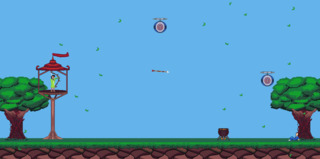
Gale is a game about shooting arrows, hitting targets and controlling the wind that guides you. It has the simple elegance of something like Desert Golfing--it’s a game that drills deep into a core loop that may seem light on the surface, but has depth found in iteration.
The game has two sets of controls: the bow and arrow that you aim and shoot, and then the wind, which you can control at will after shooting your arrow. It feels so darn cool to shoot an arrow and then quickly select the wind direction, out of four cardinal directions. The game slows time down a bit to let you consider your choice. You choose north, for example, and your arrow swiftly turns up. Perhaps that’s not quite the right direction--if your reaction time is fast enough, you can change the wind direction again. If not, the arrow flies off screen or lands dangerously close to the quiet person sitting under a tree nearby for some reason (I love this detail haha). You miss your target, you try again. Each level has a fast and satisfying loop. Playing around and testing out how the arrow flies from different angles with different wind directions as you aim for the various targets is super fun. Some targets are static, some in motion, some blocked by barriers, etc. It’s such a joyful experience to play with these mechanics, and they feel perfectly layered together. Gale is definitely my favorite action-oriented game this year.
Together

Together is a game about finding love in space played by two people on one keyboard. The game begins with each player sort of… finding each other through cameras that search through the star systems. It suggests that they’re on a dating service of some sort. Then, one player-character is introduced in his apartment--a buff and large alien. He’s very good, and you’re introduced to him running down a hallway in his apartment, feeling hopeful about this new match. His introduction carries the cinematic touch notable in games that Toby Do works on. Toby was on my previous GoTY list as well, with Meteor-Strike!. It’s exciting to follow his work, because he’s the kind of game designer that has a really unique voice that always comes through clearly.
The game proceeds and the date takes on sort of a dark-comedy turn, as apparently part of this dating service involves both parties being abducted by aliens, or so it seems. So, your date happens on an empty spaceship, which you explore together. Each player has control over their character at this point, but only of the players controls the camera. The other player-character is only visible from that perspective. Given this constraint, the players must collaborate to move together, or the player without camera control can get left behind. The game shifts perspectives a few times, so each person gets a chance at controlling the first-person view. I think this is smart and on-theme, given that you’re supposed to be on a date. The game uses keyboard as well, meaning that you’re physically close to the other player. The physical closeness and need to collaborate to move around feels really intimate in a fun and comical way. It’s awkward and endearing. Overall, the game is great for a fun laugh with a friend, and has some magical cinematic gameplay moments that are really inspiring.
We All Disappear
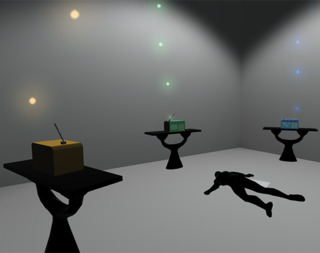
We All Disappear is a game set in a single room that contains a lot more than meets the eye. Basically, you start the game in a bare room with a dead body (the graphics are simple, so you don’t need to worry about any gore) and a radio. Turn on the radio, and a nice song starts to play. Look up, and you’ll find a note on the wall with the title of the game has appeared. More radios appear in the room. Turning another on introduces another song, which layers nicely onto the first.
The radios introduce these different layers of music, but they also lead to different iteration of the physical space in the room. There’s some drawers to open and notes to find that add to the atmosphere and mystery of the room. It is so wildly satisfying to try out all the different combinations of radios, especially because the music somehow always sounds right. I’m no musician, but it seems like it’d be really hard to write multiple tracks that all sound good together in different combinations. I love the attention to detail in each element of the game--the sound, the environment, the text you find… everything responds to the core mechanic. There’s so many layers. It’s the kind of design that makes you think… how have I not seen this before! It’s so smart! The game is the perfect size for what it is, but I can see this mechanical structure being built out into an even more complex environment. It’s inspiring to play and think about the possibilities.
Pre-Shave
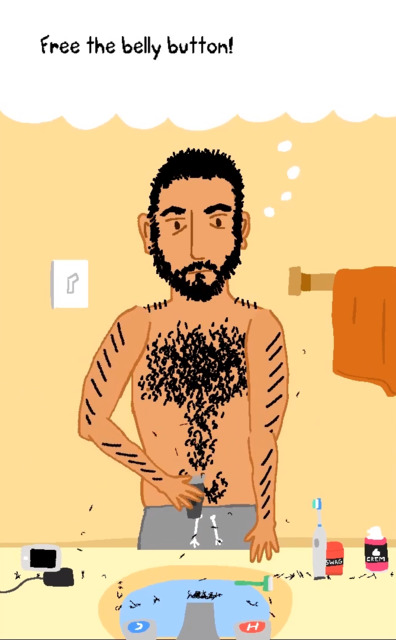
Pre-Shave is a game about getting ready to go to the airport. You play as Saam, who is also the creator of the game. He is in the bathroom with all the implements you might expect--shaving things, toothbrush, phone… and you can use all of these and more to get ready. For example, you might pick up the razor, which makes a hilariously terrifying blade unsheathing sound. Then you drag his awkward physics hands around to use it, evoking a QWOP sort of feeling. You can shave anywhere in Saam’s reach.
When I say you can shave anywhere… I mean it. His beard, his eyebrows, his chest hair--it’s all fair game. You can make him as hairless as possible. You can even turn the light off and shave in the dark if that’s your jam. Grab the toothbrush and use it like a normal person, or brush your armpits. Grab the deodorant and rub it all over your face! Pre-Shave is full of interactive bathroom things that are not bound by the rules of normal morning routines. It’s hilarious and fun to play around in the bathroom in this game--potentially the most highly interactive bathroom I’ve encountered in a game! If that’s not an accomplishment, I don’t know what is, haha. The game isn’t only about the physical comedy of a bathroom--it’s also, as the description on Itch says, “a personal game about grooming yourself as a brown man.” As silly as the mechanics are, the game is depicting something serious, which is revealed at the end. The ending has really great impact, so I don’t want to spoil it… but, I will say that the game gives a cutting comment, drawing on the lived experience of a brown man going through airport security. There’s a moment right before the ending that I’ll never forget--you actually wipe the nervous sweat off your brow. It seriously gave me goosebumps. Such a brilliant turn of the games mechanics.